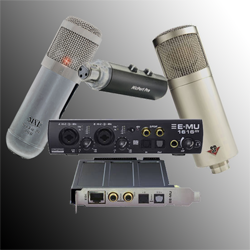Just like too much Thanksgiving feasting can be unpleasant, no matter how wonderful the food, too much emphasis on gear can be bad in several ways. By all means, check out our home recording equipment recommendations and procure what you need. But we have always tried to inspire you to let the need drive the acquisition of gear, not advice from a salesman and most insidious, your own gear lust.
Here is an article that can help you take a long hard look at how you are doing in the home recording gear department, including having too much of it.
http://www.homestudiocorner.com/bloated-home-studios/?utm_source=feedburner&utm_medium=feed&utm_campaign=Feed%3A+HomeStudioCorner+%28Home+Studio+Corner%29
Archives for November 2011
Psycho-Acoustics For The Home Studio
Understanding certain things about sound frequencies can really help us in the home studio. Psycho-acoustics is the effect that sound has on our psyche, mood, etc. Here is a really interesting article about certain sounds that make us cringe, sometimes just by think about them. This particular sound actually causes a physical change, for me anyway, when I think about or hear it. I refer, of course, to the infamous scratching of fingernails on a chalkboard.
http://www.prosoundweb.com/article/in_the_studio_scratching_the_blackboard_sound/?utm_source=feedburner&utm_medium=feed#When:21:37:32Z
sing harmony with yourself
Home Studio Awesomeness Tip: Stereo Recording
In the never-ending quest for home studio awesomeness, here is a cool article on recording in stereo. The results can be incredibly cool, but it isn’t as simple as it may appear. The constant threat when recording using multiple microphones is the weirdness (usually not the good kind) that can happen when the same sound source is multiplied in a recording. Different versions of the same sound that are slightly offset in time can battle each other, cancelling out certain parts of a sound entirely, or boosting parts of a sound way above where it should be, or both. Usually both! So certain care needs to be taken when using multiple mics and this article will help with that. Enjoy!
http://www.prosoundweb.com/article/stereo_microphone_techniques/?utm_source=feedburner&utm_medium=feed#When:13:29:20Z
Home Studio Microphone and Interface Questions Answered
 I received an e-mail this weekend asking for feedback on a few questions regarding a few specific home studio microphones and interfaces. Below is the text of the e-mail followed by my answer back to the individual who asked.
I received an e-mail this weekend asking for feedback on a few questions regarding a few specific home studio microphones and interfaces. Below is the text of the e-mail followed by my answer back to the individual who asked.
Question: Hey Ken, I have a question I thought only you could yield a pro and honest answer to. What wold you recommend between the MXL VO: 1-A from the Harlan Hogan sig. series and the Studio Projects C1?
For the audio interface, Centrance MicPort Pro, Firewire Solo, or EMU 0204? Any light shed on this subject would help a lot.
I am getting too much underlying hissing noise in my Samson C01U USB mic. I need to upgrade to a different set-up that is of higher quality, but not break the bank.
Your opinion is appreciated.
Thank You,
Brian
Answer: Hi Brian. Here are my 2-pence.
Between the MXL VO 1a from HH and the Studio Projects C1, I’d recommend going with the C1. I base this on 2 things. First, there have been some questions about the quality control with the MXL. It’s a good mic but the factory seems to be inconsistent in that some mics a really good and others are less so. That’s a concern. (see the review on this here). Secondly, Recording Magazine has been giving outstanding reviews to Studio Projects mics for the past couple of years.
On the interface question, a lot depends on your budget.
- The EMU is so much better than the other two options as to be a no-brainer if you can afford the $449 for it. Its quality is top-notch and you get a nice number of inputs (16).
- The Firewire Solo is not a good choice because it relies on old (firewire) technology and has been discontinued by most retailers.
- The Centrance MicPort Pro is a different animal altogether. Because it is not an interface “box”, but rather a small tube that will fit in your pocket (though that may not be recommended:)), it provides great flexibility and portability. And it costs a lot less than the EMU.
To answer your question about the C01U – The internal converter only allows for 16-bit recording, which will result in a higher noise floor (more hiss) than 24-bit conversion. The guts of this particular mic allow you to reduce that hiss if you increase the level of the signal to “as loud as possible.” For example, if you are recording vocals make sure to be quite close to the mic and record at as high a level as possible without distorting and that will help. However, if you really would like to avoid the hiss in the first place, you’ll need to try a converter that can record at 24 bits. Either of the interface options you asked about above will give you this if you use a non-usb mic, like either of the mics you asked about above. If you would like to continue going the USB mic route, check out the MXL Studio 24, which should give you considerably less hiss. That one costs $149.99.
So here are the options in front of you to really upgrade from just using the C01U going directly into your computer:
- Upgrade to the MXL Studio 24 for less noise: $149.99
- Get a Studio Projects C1 along with a Centrance MicPort Pro: $399.94
- Get a Studio Projects C1 along with an EMU 1616M: $698.95
I hope that helps!
Cheers!
Ken